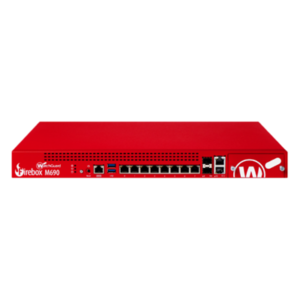SOHO Firewall
A hardware firewall usually sits behind the broadband router to protect your SOHO (small office/home office) business network from external attack. It usually analyses incoming traffic and filters out threats as they try to reach your network. The firewall acts like a perimeter fence around your network.
This hard barrier for your small office/home office (SOHO) against intrusion provides several benefits:
- Updated several times a day to provide up to date protection against new threats
- Provides an additional layer of protection against external threats
- Easy to update firewall rules via the web interface
- Helps to achieve compliance for several corporate standards and certification
A hardware firewall will prevent any devices on your network from becoming a bad actor. Bad actors are infected with malware and then used to spread malicious data as widely as possible. Data is examined in both directions and applies a set of permissions to incoming and outgoing data. If the data does not pass the permissions test, it is not allowed through.
Data carries information with it about its source, location and type. The firewall uses this to determine whether or not the data poses a threat to the network and devices on it. Data packets flagged as a threat or those that don’t pass the permission rules are rejected. A software firewall that usually form part of an antivirus solution will apply similar tests. However, the data has already managed to make it onto your business network and reached devices before hitting a firewall. Different devices will have different rules as part of its firewall or no firewall at all. Cyber criminals often view software firewalls as a soft target. They are easily accessible on the computers they look to exploit. This inevitably increases the risk for your business.
Advantages of a Hardware Firewall
- A hardware firewall is a single device that protects the entire business network and every device connected.
- The same permissions and protection are given to every device at the same time on your corporate network
- Updates applied to the firewall makes sure that the protection status is current. The updates are applied to the single device which makes them active much faster than updating each device. Some devices on your network, such as printers may not be updated for months (if ever at all) and therefore be more vulnerable to attack.
- Hardware firewalls are usually powered on and connected 24/7 providing around the clock protection to your network. Computer software firewalls are frequently turned on and off making the protection less reliable and slowing down the rate of update.
Firewall Routers
More frequently than it should, businesses use their router as the only protection against external threats. Many business grade routers include a firewall and other security features. Most routers include NAT (Network Address Translation) which hides the devices on the network from the outside world. Any data sent that has no specific destination is discarded by the router. Routers are also able to block specific types of data so that your network usually has these basic levels of protection. However, routers are not a comprehensive security solution and are rarely updated. Many new versions of malware and viruses are designed to overcome the basic protection provided by a router. In some cases, they will target routers that have old firmware and use the router to spread malicious code.
If an email containing a link is received by a user and the click the link that accesses/downloads malware, a router will allow this through. The router interprets the click as a request for the data and will allow it to bypass any checks. A hardware firewall, will block the request, even if it is as a result of a users actions.
 Telephone systems, printers and other peripherals don’t have software firewalls. Having no protection makes them vulnerable to attack and they can be used as a ‘backdoor’ into your network. Your peripherals can be used to send cyber criminals information about your network and the devices on it.
Telephone systems, printers and other peripherals don’t have software firewalls. Having no protection makes them vulnerable to attack and they can be used as a ‘backdoor’ into your network. Your peripherals can be used to send cyber criminals information about your network and the devices on it.
Which Firewall?
The hardware firewall solution that is right for your business requires serious consideration. There is a vast array of hardware firewalls with a range of features. The correct expertise is needed to install and configure both software and hardware firewalls. Threats change on a daily basis so a firewall with continuous threat updates is vital. Most firewalls require and annual subscription to the threat database.
Both software and hardware firewalls are useless if they have been incorrectly configured or if they are not updated. You don’t have to call in experts on a regular basis to update and change settings on the firewall. If it is set up correctly in the first place, it should be OK to leave for long periods of time. An annual licence renewal and a few minor tweaks are all that is required. The rest of the time, the firewall sits there doing its job 24/7.
The TST team are experienced firewall installers and we will supply and configure the right solution for your business. We will find out how your business operates and who needs to access what data. Following the installation, TST will still be available to make changes and help you manage your firewall to keep your business safe.


